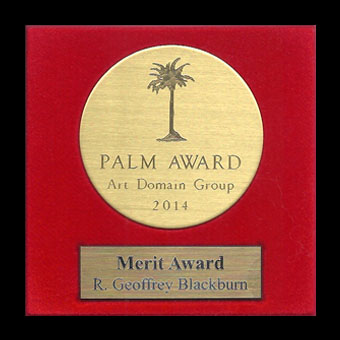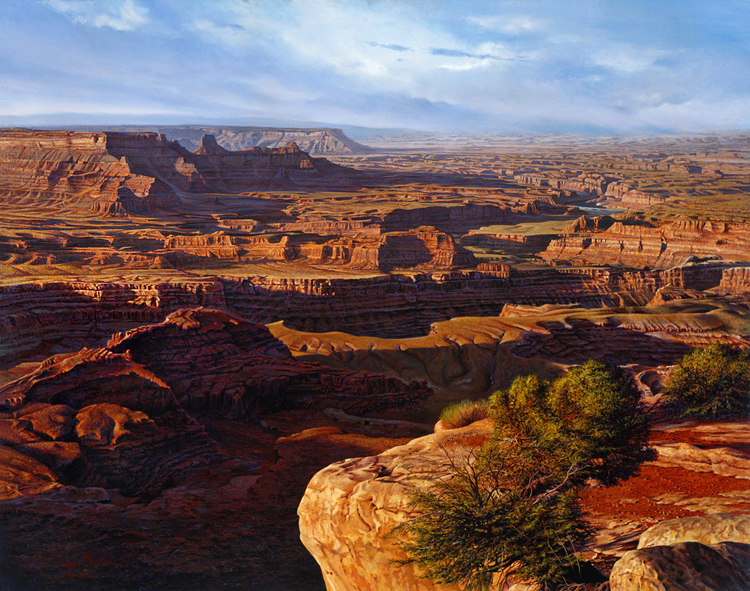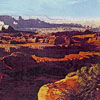| Description | Size | Price |
| Oil on Linen |
24 x 30 in (61 x 76.2 cm) | Sold |
| Giclée Print | 24 x 30 in (61 x 76.2 cm) | inquire |
| Giclée Print: (Artist's Proof) | 24 x 30 in (61 x 76.2 cm) | inquire |
| Giclée Print: | 30 x 38 in (76.2 x 96.5 cm) | inquire |
| Giclée Print: (Artist's Proof) | 30 x 38 in (76.2 x 96.5 cm) | inquire |
| Giclée Print: (Artist's Proof) | 44 x 54 in (61 x 91.4 cm) | inquire |
| Serigraph (25 color) | 30 x 42 in (81.3 x101.6 cm | Sold out |
Custom sizes and formats available contact: rgeoffrey@rgeoffrey.com
2014: Palm Art Award
Qeudlinburg, Germany

2012-2013: Featured Artist
Who's Who in Visual Art
42
Masters of Realistic Imagery
2009 Finalist: International Art Show - Part I: Realism
1985: Featured
Murder, She Wrote
"Murder At the Oasis" episode
1982: Featured Artist
The White House,
Washington, D.C.
"Red Canyons"
The Painting:
I started
"Red Canyons" in 1979
upon my return from a failed business venture in Denver.
Having lost a bundle and taking a great personal hit, I
literally escaped into my painting. I just dove into my art
and “lived” there for months! I slogged on day after day
working in an area the size of a human mouth– trying to
capture 1/25 of a second on canvas. Finally, *852
life-changing hours later, having painted through the night,
I finished "Red Canyons" just after dawn. Numb and
exhausted, I went to the mouth of Parleys Canyon in Salt
Lake City and sat in the Kmart parking lot nursing a hot
coffee and staring off into space. Finally, returning to my
studio, I put the painting under my bed where it stayed for
several months—only taking it out to show prospective
clients.
A lawyer I know came to the studio a few
times to look at "Red Canyons". He would sit there, his face
up close to the painting, turning the lights off and on
opening and closing the curtains studying the effects of the
light on "Red Canyons" as he "went into the piece." This was
a pretty typical reaction.
I took the painting to
show Maxie Anderson, CEO of Ranchers Exploration and Mining
in Albuquerque. NM. (and leader of the historic first
balloon flight across the Atlantic Ocean). Maxie Anderson
was also a serious art collector who had previously
commissioned me to paint a couple of pieces for his
collection. I was introduced to Maxie by Ranchers’ head
geologist Dave Fitch who I had taken out to show some of our
uranium properties. When Maxie, saw "Red Canyons," he wanted
it for his corporate collection but, being the
wheeler-dealer he was, he wanted to pay a couple of grand
less than I wanted for the piece, so I decided to take "Red
Canyons" and return to Salt Lake City to think about it.
I wheeled "Red Canyons" in its custom-built transport
case it into the airport and checked it at air cargo to fly
back to Salt Lake City. I flew back home. When I went to
retrieve my painting, I was told that it had vanished. For
nearly 2 weeks it remained lost. My blood pressure soared.
Finally, it turned up in (I think it was) Duluth. After the
painting and I were reunited, Maxie and I came to terms. So,
"Red Canyons" went back to Albuquerque where it remained
until after Maxie and his friend Don Ida were tragically killed in a
balloon accident in Europe.
Maxie’s company, Ranchers
Exploration and Developemnt Corp., was subsequently sold to Hecla
Mining and the painting went to Coer d’ Alene Idaho where it
hung in various corporate offices until it disappeared.
After extensive investigation we concluded that the painting
had been stolen. To this day, we have no idea who has the
painting.
2016- UPDATE: the story continues. I found
out a few months back that I had rather dense cataracts in
both eyes. I had them removed this summer. What
a shock! I actually got to see my own paintings for
the first time in decades without major color distortion!
Imagine looking at life through dark amber lenses and you
will get the idea. Apparently, cataracts play havoc with
blues and purples and totally goof up light refraction-
anyway, I was very surprised and pleased by the vibrancy of
the colors and happily, still very pleased with Red Canyons.
It could have gone the other way- my colors could have been
washed out and dull (see
Monet's work before and after cataract
surgery)...Wow, a partially blind painter... Who knew?
The Serigraph:
Before I sold "Red
Canyons" to Maxie Anderson, a well-known Seattle fine art
publisher, Larry Winn offered me a deal to publish the image
as a limited edition serigraph. I flew the painting up to
Seattle where I worked with Master Printer and artist Max
Hayslette to produce the edition. The prints turned out
great! Happily, the edition also sold out.
I spent
some of the prints like currency trading for this and that.
The number 1 print in the edition was hand-carried to
Washing D.C. and presented to
President Ronald Reagan who was so
taken with it he wrote me a very nice letter expressing his
thanks and saying that it would make a fine addition to his
Presidential Library. I was told by a high party official
that "I was very well thought of in the White House" a good
thing for a starving artist. "Red Canyons" hung in the White
House in the office of Presidential Scheduling.
Subsequently, I met and spoke with President Reagan-quite an
experience! He was a very extraordinary man!
During
this period, I had written to Robert Redford and sent him a
photo of my painting. I did not expect any response from
him. Months went by and then, out of the blue, I got a call
from his personal assistant Robbie Miller, who told me Mr.
Redford would be at Sundance and wanted to meet with me to
talk art. He was on a break from directing his Academy Award
winning film" Ordinary People" I met him at Sundance as
requested showed him the serigraph print. He seemed quite
taken with it. The two of us wrestled it up on the wall
behind his desk. We had a very interesting conversation.
Among other things, he told me that he had studied art in
Paris also that he was not only an environmentalist, but
also a developer (he gestured out the window at the Sundance
Resort as he told me this). His beautiful Sundance Ski
Resort is an excellent example of development in harmony
with nature. A cool guy!
I met and presented a "Red
Canyons" print to Secretary of State, Alexander Haig (also a
4-Star General and Supreme Allied Commander of NATO forces
in Europe). We visited and it turned out that we were both
U.S. Army Officers in the same branch, Armor. In person, he
is a very articulate, and really quite brilliant.
"Murder, She Wrote"
One evening in the mid 1980’s, I
got a call from my father-in-law who told me that my "Red
Canyons" serigraph was in an episode of the
"Murder, She
Wrote" TV show (entitled "Murder at the Oasis"). I was
dubious as I knew nothing about this. He assured me it was
true and that he was looking at it as we spoke. He sent me a
tape of the program and sure enough, there it was. They had
rolled credits over "Red Canyons" and even did the murder in
front of it! Egad! I was flattered, but also curious as to
how they got the piece in the first place. (I later learned
that they had gotten it from a Hollywood prop house). I
thought I should be compensated for the use of my image in
their TV show. So, I called Universal Television and was put
through to the studio’s head legal council. We negotiated
and came to terms and finally, they paid me.
The
Pigment Print (Giclée)
I took a decade-long break
from painting. During this hiatus, giclée prints begin
appearing in some of the galleries I visited. I was amazed
by the incredible quality and richness of these
reproductions, so I investigated the giclee printing process
and decided to make a giclée (pigment print) of "Red
Canyons". Although the serigraph version was a hugely
successful and beautiful piece, it was nonetheless an
interpretation of the original painting. This relatively new
printing process gave me the first opportunity to make a
direct, high fidelity copy of the original and retain the
vibrancy of the painting. Also, for the first time, given
the ultra-high resolution of the printing process, I could
significantly enlarge the image and really look at the
detail. So in 2005, we made our first "Red Canyons" pigment
print. I was delighted! This new pigment print version of
"Red Canyons" has been very popular with collectors. "Red
Canyons" is one of my all-time favorite paintings.
(*I
used a punch-in time clock to calculate the hours with brush
in hand)"
R. Geoffrey Blackburn



 Blackburn Studios
Blackburn Studios